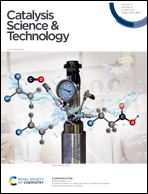Constructing CuNi dual active sites on ZnIn2S4 for highly photocatalytic hydrogen evolution†
Abstract
Noble metal Pt as an efficient cocatalyst is widely utilized in the photocatalytic hydrogen (H2) evolution field while its application is restricted by high price and scarcity. Herein, a feasible strategy for depositing a non-noble bimetallic cocatalyst on a ZnIn2S4 surface has been put forward. The low-cost and earth-abundant CuNi bimetal cocatalyst was deposited via a simple one-step photoreduction method. In this novel photocatalytic system, CuNi bimetal served as dual active sites which can inhibit the recombination of charge carriers on ZnIn2S4. Compared with single Cu or Ni deposited ZnIn2S4 samples, CuNi bimetal decorated samples showed a significant enhancement in hydrogen evolution activity. Meanwhile, 12% Cu2Ni1–ZIS realized the highest hydrogen generation rate (7825 μmol h−1 g−1, AQE = 30.19%, λ > 420 nm). The enhanced photocatalytic performance can be attributed to the spillover effect of H atoms from Ni to Cu and the synergistic effect between the metals. This work provides a novel strategy for optimizing the H2 evolution performance of a ZnIn2S4-based photocatalyst by utilizing a non-noble bimetallic cocatalyst as dual active sites.

- This article is part of the themed collection: Energy Frontiers: Hydrogen


 Please wait while we load your content...
Please wait while we load your content...